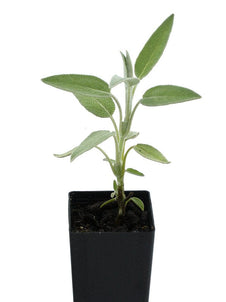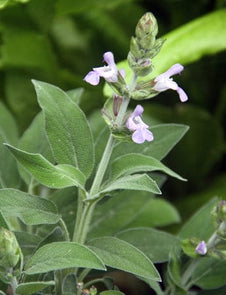





Sage - Greek Sage
Sage - Greek Sage

- Low stock - 13 items left
- Inventory on the way

Usually available: All year
Life cycle: Perennial
Height: 60cm
Position: Full sun
Soil preference: Well drained
This is how we pack and send your Herb Plants to all states except TAS & WA
You will receive
- 1 Sage - Greek Sage Herb Plant in a 50 X 75mm tube - General growing instructions
All of our Herb Plants are grown organically with certified organic potting mixes and fertilizers
Botanical Name: Salvia fruticosa 'Greek Skies'
Salvia ‘Greek Skies’ is a perennial shrub with potential to reach up to 60 cm high and 60 cm wide, with a dense growth habit. It has silver-grey to green foliage with rugose, spear shaped leaves that have a pleasant aroma. The flowers are a soft pink to blue-mauve and appear in spring held on large inflorescences, which also highlight the purple grey bracts. This salvia is rather lavender like in appearance and aroma.
Salvia “Greek Skies’ is a cross between Salvia fruticosa and Salvia officinalis. It has its origins in the Mediterranean region of Southern Italy, Greece and other countries. Salvia officinalis is the normal culinary or Common Sage most people associate with cooking. Salvia fruticosa is a culinary sage known as Greek Sage and much of the dried culinary sage, including that used in the United States, comes from this variety. Although the taste is different to Salvia officinalis, many people find it attractive and an interesting alternative. Both parents have a long history of culinary and medicinal use extended back to 1400 BC. ‘Greek Skies’ is known to create a nice herbal tea.
Salvia fruticosa is also considered easier to grow than common culinary sage and does tolerate somewhat moist soil. Greek Skies may be an alternative if Common Sage is proving difficult to grow. However, like most sages and/or salvias “Greek Skies’ is a tough plant and prefers full sun, dry, hot conditions with well drained soil. It is both drought and frost tolerant once established. This compact plant does well in containers and garden borders.
The salvia family has over 900 members with an extensive history as culinary, medicinal and ornamental plants. Ornamental salvias have become collectors items, as gardeners try to find a place in their garden for each and every one. There are salvias that will suit every type of soil and climate. More information on the Salvia genus and Common Sage (Salvia officinalis) may be found on our Common Sage page.
All information provided on this website is for informational purposes only. Please seek professional advice before commencing any treatment.





